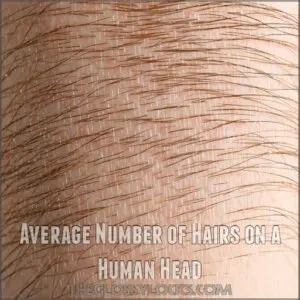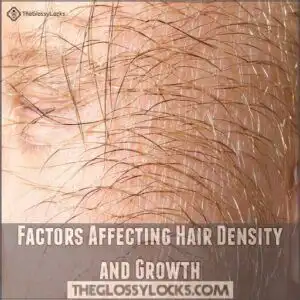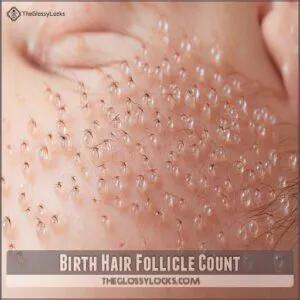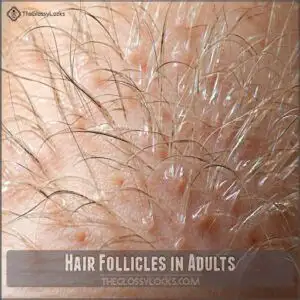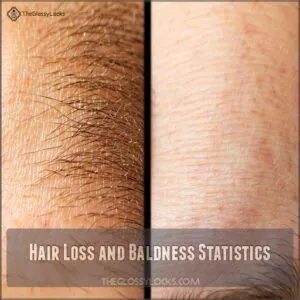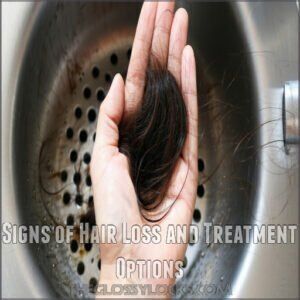This site is supported by our readers. We may earn a commission, at no cost to you, if you purchase through links.
 Ever wondered how many hairs are crowning your head? You’re in for a surprise!
Ever wondered how many hairs are crowning your head? You’re in for a surprise!
The average human scalp packs between 80,000 and 150,000 strands, depending on your hair color. Blondes typically sport the most, with around 150,000 hairs, while those with black or brown locks have about 100,000-110,000.
Your genetic blueprint plays a big role in hair density, with roughly 800-1,290 hairs per square inch of scalp. Don’t panic about daily hair loss—shedding 50-100 strands is totally normal.
Each day, your body works overtime to replace those fallen soldiers, keeping your mane looking full and fabulous.
Table Of Contents
- Key Takeaways
- Average Number of Hairs on a Human Head
- How Many Hairs Are on a Human Head
- Factors Affecting Hair Density and Growth
- The Science of Hair Follicles
- Hair Loss and Baldness Statistics
- Hair Density and Hair Color
- Increasing Hair Density
- Signs of Hair Loss and Treatment Options
- Interesting Facts About Hair Density
- Frequently Asked Questions (FAQs)
- How many hair strands are in a human head?
- How many hair follicles are on a human head?
- How many hairs are on your head?
- How many hairs does a human scalp have?
- How many hairs does a man have?
- How many hairs does the average person have a day?
- Does hair have DNA on it?
- Can you determine age from hair?
- How to detect hair loss?
- How many hairs are on an average head?
- Conclusion
Key Takeaways
- You’ll typically have between 80,000 to 150,000 hairs on your head, with the exact number influenced by your hair color and genetics.
- Blondes tend to sport the most hair, averaging around 150,000 strands, while those with black or brown hair have about 100,000-110,000 hairs.
- It’s totally normal to lose 50-100 hairs daily, as your body continuously replaces fallen strands to maintain consistent scalp coverage.
- Your hair’s density and count are primarily determined by your genetic blueprint, with factors like race, hormones, and nutrition playing supporting roles in your unique hair landscape.
Average Number of Hairs on a Human Head
Have you ever run your fingers through your hair and wondered just how many strands are dancing beneath your fingertips?
The average human scalp is home to a staggering 80,000 to 120,000 hairs, a number that might surprise you.
Due to the sheer size of the global population and the pigeonhole principle, thousands of people likely share your exact hair count.
Your unique hair follicle count depends on several fascinating factors.
Hair color plays a surprising role – blondes typically sport around 150,000 hairs, while those with black or brown hair might’ve closer to 100,000-110,000 strands.
Each day, you’ll naturally shed about 50-100 hairs as part of your hair growth patterns.
Don’t panic – this is totally normal!
Your scalp coverage remains consistent because new hairs continuously replace those that fall out.
Think of your hair like a diverse ecosystem, with each strand telling a unique story.
Whether you’re sporting a thick mane or a more modest head of hair, your human hair types are a reflection of your individual genetic blueprint.
How Many Hairs Are on a Human Head
You’ve probably wondered about the hair population residing on your head.
Buckle up for a fascinating journey through hair count variations!
The average human scalp hosts between 80,000 to 150,000 individual hairs, creating a unique follicle landscape that’s as individual as a fingerprint.
Factors like genetics and nutrition can influence your overall hair density.
- Hair Count Diversity: Your head can sport anywhere from 100,000 to 150,000 strands
- Density Details: Roughly 800-1,290 hairs occupy each square inch of scalp
- Color Connections: Hair color impacts strand count (blonde leads, black follows)
- Daily Shedding: Losing 50-100 hairs daily is totally normal
Think of your scalp as a bustling city, with each hair a tiny resident moving through its growth cycles.
From thick manes to subtle coverage, your hair tells a remarkable story of biological complexity and individual uniqueness.
Factors Affecting Hair Density and Growth
Ever wondered why your hair looks different from your siblings or changes as you age?
Understanding the complex factors affecting hair density and growth can help you appreciate the unique characteristics of your locks.
Managing potential changes in your hair’s appearance and health can be achieved by understanding these factors, including how they impact your hair’s appearance.
Genetics and Hair Growth
Your hair’s journey begins deep within your genetic blueprint.
Like a unique signature, hair inheritance determines your locks’ destiny.
From the follicle development to growth patterns, your ancestors’ DNA dictates everything.
Some people inherit thick, luxurious hair that seems to grow overnight, while others struggle with thinner strands.
Genetic variance plays a pivotal role in hair density, influencing the average hair count and the intricate hair growth cycle that defines your crowning glory.
Hormonal Imbalances and Hair Loss
Your body’s hormonal rollercoaster can dramatically impact hair health, turning those luscious locks into a thinning landscape.
Imbalances from stress, thyroid dysfunction, or menopause disrupt your hair follicles’ natural rhythm, and Androgen levels play a massive role in hair loss, especially with conditions like hyperandrogenism.
Imagine your scalp as a delicate ecosystem where hormone therapy might be the restoration plan, and Cortisol spikes can send your hair growth cycles into chaos, causing unexpected shedding.
Women experiencing hormonal shifts often notice dramatic changes in hair density.
The good news is that understanding these triggers is the first step to reclaiming your hair’s radiance.
Nutrition and Hair Health
Hormonal hiccups got you worried about hair loss? Your diet might be the secret weapon!
Vitamin intake and mineral balance are like superhero nutrients for your locks.
Imagine your hair as a garden – the right dietary habits are the fertilizer that helps it thrive.
Finding the right hair health vitamins can supplement a healthy diet.
Load up on proteins, omega-rich foods, and hair supplements.
Eggs, salmon, and spinach can be your hair’s best friends.
Balanced nutrition isn’t just good for your body – it’s your hair’s ultimate growth strategy.
Aging and Hair Density
Your hair’s journey through aging isn’t just about going gray—it’s a complex transformation affecting density and follicle health.
As you age, your hair growth rate slows down, leading to noticeable thinning and reduced hair count.
Maintaining a healthy lifestyle, balanced diet, and scalp care can help combat these natural changes and preserve your locks’ liveliness.
The Science of Hair Follicles
Ever wondered how many tiny hair factories—called follicles—are hiding in your scalp, waiting to sprout those luscious locks?
You’ll be amazed to learn that each human head contains around 100,000 hair follicles, which are microscopic structures responsible for producing and growing your unique hair strands.
Birth Hair Follicle Count
Buckle up for a hair-raising journey into your fetal follicle formation.
When you’re born, you’re packed with roughly five million hair follicles, most clustering on your scalp like tiny biological solar panels.
Check out these follicular facts:
- Genetic blueprints determine your unique follicle landscape
- Follicle size dictates hair texture from day one
- Early follicle activity can hint at future hair patterns
Variations in Hair Follicle Count Based on Hair Color
Your genetic blueprint isn’t just a map of traits—it’s a hair color lottery that determines your follicle count.
Blondes typically win big with around 120,000 strands, while redheads cash in fewer chips at roughly 80,000.
The MC1R gene plays conductor in this melanin orchestra, influencing not just pigmentation but also hair density.
Each hair color tells a unique story of genetic variation, with darker shades absorbing more light and creating an illusion of thickness that goes beyond mere strand count.
Hair Follicles in Adults
Your hair follicles are life’s storytellers, revealing how aging impacts hair thickness and texture.
As we age, hair growth patterns change, and you can learn more about this from this helpful resource on aging and hair growth cycles.
While you started with abundant follicles, adult counts hover around 100,000, presenting unique challenges for maintaining lush locks.
- Hair follicle distribution changes subtly with time
- Adult shedding patterns shift unpredictably
- Follicle health becomes increasingly nuanced
Understanding these rhythms helps you navigate your hair’s evolving landscape with confidence.
Hair Loss and Baldness Statistics
You might be surprised to learn that hair loss affects millions of people worldwide, with male pattern baldness being the most common type.
Whether you’re experiencing thinning hair or just curious about the science behind hair loss, understanding the statistics can help you navigate this common yet complex biological process.
Male Pattern Baldness
Ever wondered why your hairline’s playing hide and seek?
Male pattern baldness isn’t just a numbers game – it’s a complex dance of genetics and hormones.
Check out this breakdown:
| Stage | Description | Age Range |
|---|---|---|
| Early | Slight Recession | 20-30 |
| Moderate | Temple Thinning | 30-40 |
| Advanced | Crown Balding | 40-50 |
| Severe | Widespread Loss | 50+ |
Understanding triggers helps you take control of your scalp’s story.
Female Hair Loss
When hormones play tag with your locks, female hair loss becomes a reality.
Women face unique challenges: thinning strands, reduced volume, and scalp visibility.
A balanced diet supports hair health, according to this female hair loss prevention resource.
Stress and menopause amplify these changes, impacting your hair’s health and density.
| Trigger | Hair Impact | Solution |
|---|---|---|
| Hormones | Thinning | Hormone therapy |
| Stress | Shedding | Wellness practices |
| Genetics | Volume loss | Targeted treatments |
Chemotherapy and Hair Loss
When cancer strikes, your hair might wave goodbye during chemotherapy.
Those powerful drugs target rapidly growing cells, including your precious hair follicles.
But don’t lose hope – most patients see regrowth within months.
Hair loss isn’t forever.
| Stage | Experience |
|---|---|
| 2-3 Weeks | First signs of hair loss |
| 6-8 Weeks | Potential hair regrowth begins |
| Post-Treatment | Hair texture might change temporarily |
Hair Density and Hair Color
You might be surprised to learn that your hair count isn’t just a random number, but a fascinating genetic story told through density and color.
Depending on whether you’re blonde, brown, black, or red-haired, you’ll have anywhere from 90,000 to 150,000 hair strands covering your scalp, with each strand revealing unique characteristics about your genetic heritage.
Hair Density Differences in Different Races
Ever wondered why your hair looks different from your friend’s?
Ethnic hair types tell a fascinating story of diversity:
- Caucasian hair density peaks at 230 strands/cm²
- African hair averages 150 strands/cm²
- Hispanic hair ranges between 169-178 strands/cm²
- Asian hair varies with unique follicle characteristics
Racial variations in hair texture and follicle distribution reveal nature’s incredible genetic blueprint.
Genetic Factors in Hair Density
Ever wondered why your hair looks different from your siblings?
Your genes are the secret storytellers, crafting a unique blueprint for your hair density and texture.
Your genetic influence plays a massive role in determining how many hair follicles you’ll have and how thick they’ll be.
Some ethnicities naturally boast higher average hair count on head, while others showcase different inheritance patterns.
Your family tree whispers clues about potential hair density by race and hair density by gender.
From fine strands to lush locks, your DNA writes the script – and sometimes, those genetic surprises can totally catch you off guard!
Increasing Hair Density
You’ve been wondering about boosting your hair’s thickness and volume, and the good news is that you’ve got more control than you might think.
With strategic treatments and a solid understanding of your genetic blueprint, you can take practical steps to potentially increase your hair density.
You can achieve the lush, full head of hair you desire by following these steps.
Hair Growth Treatments and Techniques
Struggling with thinning locks? Hair restoration techniques can turn the tide on hair loss.
Consider these powerful solutions:
- Minoxidil: FDA-approved topical solution stimulating follicle growth
- Laser Therapy: Non-invasive treatment boosting hair density
- Scalp Massage: Natural technique improving blood circulation
- PRP Therapy: Cutting-edge treatment using your body’s healing potential
Each method targets hair growth differently, offering hope for those battling hair loss.
A range of hair growth treatment products are also available to support these techniques. Your journey to fuller, healthier hair starts here.
The Role of Genetics in Hair Density
After exploring hair growth treatments, let’s unpack the genetic blueprint of your locks.
Your hair’s story is written in your DNA, with inheritance patterns determining everything from texture to density.
Genetic influence shapes your follicle distribution, explaining why some families share similar hair characteristics.
Whether you’ve got thick, thin, curly, or straight strands, your genes are the master storytellers.
Understanding these inherited traits can help you better manage your unique hair journey and set realistic expectations about hair density and hair growth.
Signs of Hair Loss and Treatment Options
You mightn’t realize it, but losing 50-100 hairs daily is completely normal.
Spotting early signs of excessive hair loss can help you take proactive steps.
Understanding the treatment options and potential causes will empower you to maintain your hair’s health and boost your confidence.
Detecting Hair Loss
Hair loss doesn’t happen overnight.
Your scalp tells a story through subtle changes in hair density, shedding patterns, and follicle health.
Look for thinning patches, increased hair fall during washing or brushing, and changes in hair texture.
Early detection is your secret weapon in maintaining a full, vibrant head of hair – so keep a keen eye on these telltale signs, utilizing early detection as a key factor.
Treatment Options for Hair Loss
The miracle of modern medicine offers hope for those battling thinning locks.
When hair loss strikes, you’ve got options to fight back:
- Try minoxidil for follicle stimulation
- Explore hair transplantation techniques
- Consider platelet-rich plasma (PRP) treatments
- Investigate low-level laser therapy
- Consult professionals for personalized hair restoration strategies
A range of hair loss treatment products are also readily available, to help you reclaim your confidence, one strand at a time, through hair restoration and hair loss treatment.
Interesting Facts About Hair Density
Got curious about hair density? After learning how to detect hair loss, you’ll love these mind-blowing facts about your mane’s mysterious world.
To fully understand your hair, it’s helpful to learn about different hair density types.
| Hair Color | Average Strands | Strand Characteristics |
|---|---|---|
| Blonde | 150,000 | Fine, fluffy |
| Brown | 110,000 | Medium thickness |
| Red | 90,000 | Thick, robust |
Your hair’s a marvel: 85-90% stays in growth mode, ready to stretch up to 30% when wet without breaking. Blondes might boast more strands, but each hair tells a unique story.
Genetics play conductor in this follicular symphony, orchestrating thickness, color, and growth patterns.
Want to discover your scalp’s secrets? Understanding hair density isn’t just science—it’s your personal roadmap to luscious locks that turn heads and boost confidence.
Frequently Asked Questions (FAQs)
How many hair strands are in a human head?
You’ll find most heads sport around 100,000 to 150,000 hair strands, with variations depending on hair color and genetics.
Blonde folks typically boast the most, while redheads have slightly fewer crowning glory threads.
How many hair follicles are on a human head?
Like a lush forest of follicles, your scalp hosts roughly 100,000 tiny hair producers. You’ll typically have about 100,000 hair follicles, which can vary based on genetics, age, and individual characteristics.
How many hairs are on your head?
You’ve likely got between 100,000 and 150,000 hairs on your head, with blondes averaging closer to 150,000 and redheads around 90, Your unique genetics determine your personal hair count‘s exact number.
How many hairs does a human scalp have?
Your scalp’s a lush forest, teeming with life.
On average, you’ll sport between 100,000 and 150,000 hairs, with variations based on hair color, genetics, and individual differences.
Each strand tells a unique story of growth and resilience.
How many hairs does a man have?
You’ll find around 100,000 hairs on an average man’s head, with variations based on hair color, genetics, and individual factors.
Blonde guys typically sport more hair, while factors like age can impact overall count.
How many hairs does the average person have a day?
You’ll naturally lose 50-100 hairs daily as part of your body’s normal hair cycle.
This shedding is totally normal and doesn’t mean you’re going bald – it’s just your hair’s natural renewal process in action.
Does hair have DNA on it?
With 100,000 strands on your noggin, you’ve got a treasure trove of genetic clues.
Hair roots and follicles contain DNA, making them valuable for forensic testing and personal identification when the root is intact.
Can you determine age from hair?
You can determine a person’s approximate age through hair analysis by examining chemical composition, telomere length, and gray hair percentage.
Forensic scientists and researchers use advanced techniques to estimate biological age from hair samples.
How to detect hair loss?
Imagine losing clumps of hair in the shower, watch for increased shedding, thinning patches, receding hairline, and visible scalp.
Check your pillow and brush daily.
Consult a dermatologist if hair loss persists or seems abnormal.
How many hairs are on an average head?
You’ve got around 100,000 to 150,000 hairs on your head, with variations depending on your hair color and genetics.
Blondes tend to have more, while the count can differ based on individual characteristics.
Conclusion
Ultimately, the number of hairs on a human head is a fascinating journey of genetics, color, and individual variation.
You’ve discovered that how many hairs are on a human head ranges from 80,000 to 150,000, with factors like genetics, age, and health playing pivotal roles.
Whether you’re blonde, brunette, or somewhere in between, your unique scalp tells a remarkable story of biological diversity and personal identity.

